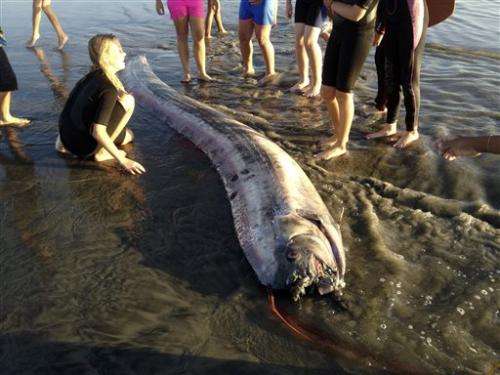California 'sea serpents' draw gawkers

The silvery carcasses of two giant oarfish were discovered along the Southern California coast last week, baffling scientists and gaining a growing online following who gawked at the bony, snake-like creatures.
A 14-foot (4.3 meter) oarfish washed up on a beach in the San Diego County coastal city of Oceanside last Friday. Several days earlier, a snorkeler found the carcass of an 18-foot oarfish off Catalina Island and dragged it to shore with some help.
The rarely seen deep-sea dwellers, which can grow to more than 50 feet, may be the inspiration of sea monsters found in literature and throughout history.
Here's a closer look at the oarfish:
HOW OFTEN DO THEY VENTURE CLOSE TO SHORE?
Oarfish beach themselves around the world. Every so often, one wanders to the Southern California coast.
HOW DID THE TWO OARFISH DIE?
While necropsies—the animal version of an autopsy—were done on the oarfish, the cause of death remains unknown. Scientists said the deaths may forever remain a mystery. The smaller oarfish appeared to be in good health before it died and there were no signs of shark bites.
Oarfish are thought to be poor swimmers, so maybe the ones found last week got caught in a current that pushed them to coastal waters, marine experts said.
"If they get disoriented and into the surf zone, they'll probably have trouble maneuvering back out to sea," said Phil Hastings, curator of the marine vertebrate collection at the Scripps Institution of Oceanography.
WHY IS SO LITTLE KNOWN ABOUT OARFISH?
Oarfish tend to remain quiet in the deep ocean, luring smaller fish toward them.
Since they are found in tropical waters 3,000 feet deep, scientists get few opportunities to study them. The dead oarfish that float ashore don't tell the whole story. It's like trying to study deer killed on the road, said Milton Love, a marine biologist at the University of California, Santa Barbara.
"You wouldn't know much about deer based on roadkill," he said.
WHAT'S NEXT?
Scientists have dissected the oarfish, preserved some tissue and organs, and planned to send samples to researchers around the world.
© 2013 The Associated Press. All rights reserved.



















